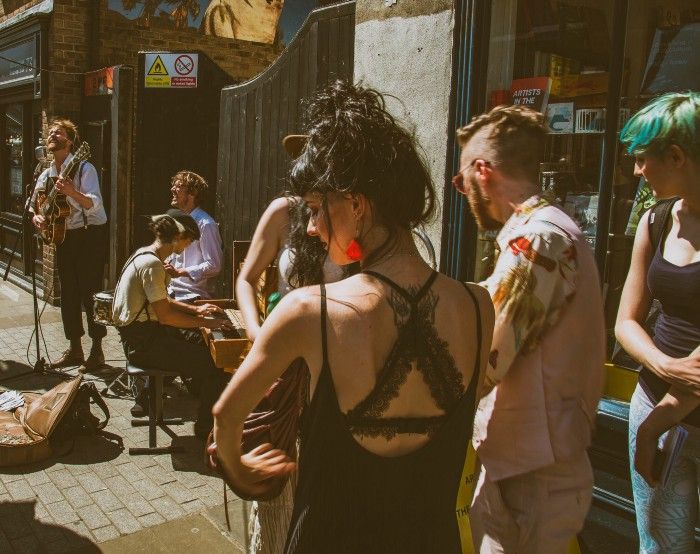by Orit Gal
Orit Gal is a senior lecturer in strategy and complexity at Regents University London and is the founder of smartphone app Urbaniser, 'your new city organiser - never forget a place!' Urbaniser is a great way of organising your own lifestyle and helping to support small independent businesses hit by the coronavirus lockdown in any town, anywhere. Orit blogs on Medium and on Urbaniser's website

It started with a little café offering some gluten-free muffins over a rugged wooden counter, a few utilitarian tables set against a white brick wall, and a laidback bearded barista. Next came a throwback homeware shop selling enamel mugs, extra-long candles, and some wooden brooms; a Japanese inspired boutique selling all things black; an over-the-top eyewear micro-shop; and a couple of designer pop-ups. Overtime, a fresh pasta deli opened just across the road, followed by another bistro adhering to the ‘rustic meets industrial’ vibe. The old bookstore, convenience shop, dry cleaners, and local pub also seemed to enjoy the new attention, with more and more people flocking to the revitalized high-street. Busker musicians on weekends and some vibrant graffiti art added the final touches — this was the next instagrammable cool hood!
And yet there was a caveat in the story. Like all social ecologies, this one also continued to evolve, reshaped by the gravitational forces of its own making. As demand for both residential and business properties in the area skyrocketed, so did prices, setting off the next wave of transformation. Within a couple of years, small independent shops and cafés had been replaced by global brands taking over larger spaces. Once Versace and Starbucks moved in, you got the sense that it was over. Some of that undefinable urban vibe was lost, footfall decreased, and commercial activity could no longer justify the business rates and rents demanded by property owners and the city apparatus. The high-street faltered under the weight of its own success, turning the neighbourhood into another ubiquitous overpriced suburb, with increasing high-street vacancies dotted amongst a few recognisable branded shops.
This is not just a London story, but one which is currently repeating itself across many of our great global cities. As Derek Thompson noted in his recent analysis of Manhattan “Long stretches of famous thoroughfares — like Bleecker Street in the West Village and Fifth Avenue in the East 40s — are filled with vacant storefronts. Their dark windows serve as daytime mirrors for rich pedestrians. It’s like the actualization of a Yogi Berra joke: Nobody shops there anymore — it’s too desirable.”[i] But why and how does this come about? Much has been written about the forces driving the decline of traditional town centres as old shopping habits were reshaped by new working patterns and digital consumption platforms. However, you would think that newer and more adapt commercial clusters set in seemingly prime locations would find it easier to survive.
So here is the puzzle — we know that people want to live and hang out in vibrant neighbourhoods with a mix of shops, public spaces, and amenities that can provide them with a break from their daily routines. They want places whose offers cannot be catered to online, and ones that can give them a combined sense of social discovery and familiarity. The question is why wouldn’t the free market be able to meet this demand? Traditional economics would call this puzzle a market failure — whereby the preferences of multiple consumers, traders, and landlords are not being translated into an efficient market environment. But how do such market failures come about? Is there something within the very nature of today’s local urban economies that renders failure inevitable?
We tend to think of markets as having clear cause and effect relations. For example, if people want bubble tea then new bubble tea shops will pop up on every corner; once demand for odd jelly balls concoctions slows, they would just disappear. Thinking about how our local city centres developed over centuries, this generally rings true. Communities needed goods and services, hence came the entrepreneurial butcher, baker and candlestick maker, and more recently supermarkets and department stores. For most of our urban history, people spent much time shopping for life’s necessities, at the same time increasing demand for snack bars, cafes, and eateries.
What emerged was a vibrant local economy, and with it a natural opportunity for people to share news, discover new ideas, and strengthen social bonds. In other words, wherever enough density of people existed, local city centres self-organized spontaneously through the accumulated actions of consumers and shop owners. Local councils had to do very little to generate a successful organic economic ecology. However, for such an organic process to work effectively there must be clearly identifiable individual needs that can be supplied by individual vendors. It is this crucial element that seems to have been obscured within our current urban environments.
For a century now, shopping for life’s necessities has become ever faster, easier and more physically remote from the places we live. First came the self-service supermarkets freeing customers from queuing to be served over small shop counters, then came the out of town centres, which together with the spread of refrigerators, trollies and cars made household shopping a weekly rather than a daily hassle. Big department stores provided similar transformations for apparel and homeware. Then of course came online shopping, liberating us completely from most physical errands. Today, it is hard to think of actual products that cannot be ordered sometime after 11pm from the comfort of our living room sofas. In which case, apart from cafes, restaurants, and nail bars, it is difficult to identify clear individual needs that local high-streets could cater to. Yet high streets made just of eateries and hairdressers will never create enough of a gravitational pull for great local hubs to thrive.
So, does that mean that local commercial centres have become redundant? Absolutely not! Not only is public excitement obvious for all where the right commercial mix does miraculously emerge — wandering through vibrant streets and discovering the new can never be replicated online, but crucially these hubs do serve some clearly identifiable needs. Having said that, these needs are of a different nature — rather than a set of specified products, what people are craving for is a set of systemic patterns. People do not flock to great high streets for enamel mugs, they come for the great urban vibe.
A great urban vibe is a social-economic pattern. It cannot be intentionally delivered by individuals, it emerges simultaneously from whatever everyone does. It takes a certain density of people to be present on the street, not simply on their way from point A to B, but hanging around for a bit, interacting with the public space and everything that surrounds it. In the old town centres, the opportunity for people to share information, discover new ideas, and strengthen social bonds could have been thought of as a positive side effect, a by-product of a thriving goods economy. However, spending time in public, doing a bit of people watching and socialising is a deep human need in its own right.
We are social animals having to rely on collaborative networks for our survival, and healthy urban vibes provide the best conditions for economic and social networks to operate. Random collisions between people and the opportunity to observe others provide vital signals and information flows for effective collaboration, as well as a sense of security. Yet given its systemic nature, it cannot be directly delivered by individual traders and therefore by the market — hence the market failure. Now that much of the economic rationales for physically shopping necessities is gone, we must focus on developing new innovative ways to recreate it. The question is — can we design for a great urban vibe?
If the necessary conditions for an urban vibe to emerge cannot be provided via traditional markets, we need a different approach, one in which the mixture of amenities and public spaces is curated as a whole so as to enhance the social patterns people truly crave. Much research and experimentation has already gone into the design of public spaces, for example how putting in movable chairs can induce a sense of temporary ownership and ease, or how artistic focal points can motivate people to walk more, whilst also encouraging conversations among strangers. At the same time, when it comes to the mix of commercial retail around public spaces, these have largely been left for the free market to optimize. Yet as suggested above, such market optimization had been rare and rather temporary. We therefore need an alternative approach to designing our local retail environments. Instead of leaving it up to faltering supply and demand, cities could intentionally curate them as holistic ecologies.
Curating a high-street means having the ability to think holistically about all the offerings of shops and services a certain high-street would provide. This, as opposed to the fragmented individual negotiations between landlords and businesses as currently practiced. Putting aside the obvious challenges of property ownership, the key idea here is that a curated high-street would have a much better chance to deliver the systemic social and economic needs of its communities, and in that sense also the long-term returns for landlords. Yet it is imperative to stress that a curation process does not mean “design by committee”. Rather, given our understanding of the complex nature of urban vibes, the curation process should follow three key principles:
a. Defining new strategic objectives — from the city’s perspective, the aim of curating a whole local high street would be to maximize a continuous urban vibe. Current regeneration projects have tended to focus on achieving accumulative individual outputs such as trade or footfall. New data indicators must therefore be developed for operationalising the patterns that good urban vibes reflect, taking under consideration unique local contexts.
b. Inserting elements of randomness — there is no recipe for a great urban vibe. While we can generally identify the patterns that make it up, the winning combination of shops and services is impossible to predict. Like all evolutionary process it is also down to chance, an attribute that should be embraced within the design process. This can be done by allowing certain retail choices to be determined by random draws rather than via a rationalized decision-making process.
c. Designing via continuous modification — social ecologies are dynamic by nature. This must also be reflected within the curation process which has no end point, but rather must be responsive to data analysis and feedback from the public. Experimentation through regular changes in the content of offerings on the high-street will also deliver on the social need for discovery, an inherent driver in the demand for urban vibe.
More than half of humanity is urban, a proportion expected to rise to 75% by 2030. Given that cities have always served as our most effective vehicles for creativity and innovation, that should be seen as a good thing. After all, it is the sense that everything is possible that has made cities like London, New York, Hong Kong and Mumbai the great human hubs they are today. Yet they will only continue to be so if they can provide thriving local ecologies for their residents, not just centralized international hubs. Given today’s economic, technological, and cultural trends, we must actively help these to re-emerge, addressing our current market failures and co-designing the vibrant social neighbourhoods we all want to live in.
[i] Derek Thompson, “How Manhattan Became a Rich Ghost Town” https://medium.com/the-atlantic/how-manhattan-became-a-rich-ghost-town-a59edb0399b8


